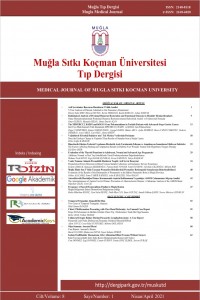Olgu Sunumu
Yıl 2021,
Cilt: 8 Sayı: 1, 55 - 57, 30.04.2021
Öz
Chiari malformasyonu (CM) santral sinir sisteminin en sık görülen malformasyonlarından birisidir. Bu durum siringomiyeli, hidrosefali ve ilişkili patolojiler ile birlikte görülebilir. Bu yazıda nadir görülen bir CM klinik bulgusu anlatılmaktadır. Daha önce ulnar sinir hasarı nedeniyle yanlış tanı konulmuş ve transpozisyon cerrahisi uygulanmış pençe el deformitesi olan 45 yaşında erkek hasta polikliniğimize pençe el deformitesi ile başvurdu. Yapılan elektronöromiyografi (ENMG) sonrasında ulnar sinirde herhangi bir iletim problemi saptanmadı. Yapılan değerlendirmede hasta sirings kavitesi olan CM tip-1 tespit edildi. Hasta ileri tedavi amacıyla beyin cerrahisi kliniğine konsulte edildi. CM tip-1 sıklıkla siringomiyeli ile birlikte görülür. Pençe el sıklıkla travmatik ya da tumor ilişkili sirinks kavitesi ile ilişkilidir ancak CM tip-1 ile birlikteliği nadirdir. Bu gibi hastalarda farklı sebeplerinde olabileceği akılda tutulmalıdır.
Anahtar Kelimeler
Kaynakça
- 1. Novegno F, Caldarelli M, Massa A, et al. The natural history of the Chiari type I anomaly. J Neurosurg Pediatr. 2008;2:179-87.
- 2. Da Silva JA, Brito JC, da Nobrega PV. Autonomic nervous system disorders in 230 cases of basilar impression and Arnold-Chiary deformity. Neurochirurgia (Stuttg). 1992;35:183-8.
- 3. Cavender RK, Schmidt JH. Tonsillar ectopia and Chiari malformations: Monozygotic triplets: Case report. J Neurosurg. 1995;82:497-500.
- 4. McGirt MJ, Attenello FJ, Atiba A, et al. Symptom recurrence after suboccipital decompression for pediatric Chiari I malformation: analysis of 256 consecutive cases. Childs Nerv Syst. 2008;24:1333-9.
- 5. Dolgun H, Turkoglu E, Kertmen H, et al. Chiari Type I malformation presenting with bilateral hearing loss. J Clin Neurosci. 2009;16:1228-30.
- 6. Rosetti P, Ben Taib RO, Brotchi J, et al. Arnold Chiari Type 1 malformation presenting as a trigeminal neuralgia: Case Report. Neurosurgery. 1999;44:1122-4.
- 7. Kanpolat Y, Unlu A, Savas A, et al. Chiari Type 1 malformation presenting as a gloosopharyngeal neuralgia: Case Report. Neurosurgery. 2001;48:226-8.
- 8. Pareyson D, Marchesi C. Diagnosis, natural history, and management of Charcot–Marie–Tooth disease. Lancet Neurol. 2009;8:654-67.
- 9. Neiman R, Maiocco B, Deeney VF. Ulnar nerve injury after closed forearm fractures in children. J Pediatr Orthop. 1998;18:683-5.
- 10. Malaviya GN. Correction of claw fingers in leprosy-current status. Acta Leprol. 1991;7:389-95.
- 11. Shenoy SN, Raja A. Cystic cervical intramedullary schwannoma with syringomyelia. Neurology India. 2005;53:224-5.
- 12. Bains RS, Althausen PL, Gitlin GN, et al. The role of acute decompression and restoration of spinal alignment in the prevention of post-traumatic syringomyelia: case report and review of recent literature. Spine. 1976;26:399–402.
- 13. Pettorini LB, Oesman C, Magdum S. New presenting symptoms of Chiari I malformation: report of two cases. Childs Nerv Syst. 2010;26:399-402.
Yıl 2021,
Cilt: 8 Sayı: 1, 55 - 57, 30.04.2021
Öz
Chiari malformation (CM) is one of the most common malformations of central nervous system. It may be seen with syringomyelia, hydrocephalia and associated pathologies. We described an uncommon clinical presentation of CM in this paper. We report a case of 45 years old male patient consulted to our outpatient clinic with claw hand deformity who had misdiagnosed as ulnar entrapment neuropathy and undergone transposition surgery. We performed electroneuromyography (ENMG) to the patient and revealed normal conduction in ulnar nerve. We focused on the other causes of the deformity and found CM type-I with a syrinx cavity. We consulted the patient to neurosurgery clinic of our center for further treatment. CMI is often associated with syringomyelia. Claw hand is oftenly associated with traumatic or tumor related syrinx cavity but association with CMI is very unusual. We recommend the evaluation of such patients more carefully focusig on different causes.
Anahtar Kelimeler
Kaynakça
- 1. Novegno F, Caldarelli M, Massa A, et al. The natural history of the Chiari type I anomaly. J Neurosurg Pediatr. 2008;2:179-87.
- 2. Da Silva JA, Brito JC, da Nobrega PV. Autonomic nervous system disorders in 230 cases of basilar impression and Arnold-Chiary deformity. Neurochirurgia (Stuttg). 1992;35:183-8.
- 3. Cavender RK, Schmidt JH. Tonsillar ectopia and Chiari malformations: Monozygotic triplets: Case report. J Neurosurg. 1995;82:497-500.
- 4. McGirt MJ, Attenello FJ, Atiba A, et al. Symptom recurrence after suboccipital decompression for pediatric Chiari I malformation: analysis of 256 consecutive cases. Childs Nerv Syst. 2008;24:1333-9.
- 5. Dolgun H, Turkoglu E, Kertmen H, et al. Chiari Type I malformation presenting with bilateral hearing loss. J Clin Neurosci. 2009;16:1228-30.
- 6. Rosetti P, Ben Taib RO, Brotchi J, et al. Arnold Chiari Type 1 malformation presenting as a trigeminal neuralgia: Case Report. Neurosurgery. 1999;44:1122-4.
- 7. Kanpolat Y, Unlu A, Savas A, et al. Chiari Type 1 malformation presenting as a gloosopharyngeal neuralgia: Case Report. Neurosurgery. 2001;48:226-8.
- 8. Pareyson D, Marchesi C. Diagnosis, natural history, and management of Charcot–Marie–Tooth disease. Lancet Neurol. 2009;8:654-67.
- 9. Neiman R, Maiocco B, Deeney VF. Ulnar nerve injury after closed forearm fractures in children. J Pediatr Orthop. 1998;18:683-5.
- 10. Malaviya GN. Correction of claw fingers in leprosy-current status. Acta Leprol. 1991;7:389-95.
- 11. Shenoy SN, Raja A. Cystic cervical intramedullary schwannoma with syringomyelia. Neurology India. 2005;53:224-5.
- 12. Bains RS, Althausen PL, Gitlin GN, et al. The role of acute decompression and restoration of spinal alignment in the prevention of post-traumatic syringomyelia: case report and review of recent literature. Spine. 1976;26:399–402.
- 13. Pettorini LB, Oesman C, Magdum S. New presenting symptoms of Chiari I malformation: report of two cases. Childs Nerv Syst. 2010;26:399-402.
Toplam 13 adet kaynakça vardır.
Ayrıntılar
| Birincil Dil | İngilizce |
|---|---|
| Konular | İç Hastalıkları |
| Bölüm | Olgu Sunumu |
| Yazarlar | |
| Yayımlanma Tarihi | 30 Nisan 2021 |
| Gönderilme Tarihi | 23 Mart 2019 |
| Yayımlandığı Sayı | Yıl 2021 Cilt: 8 Sayı: 1 |


